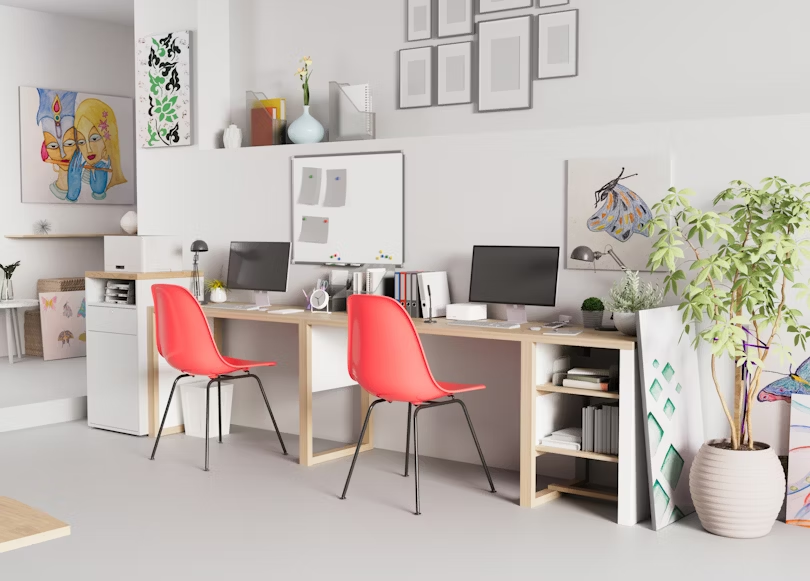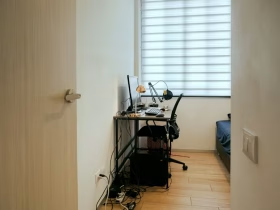The rise of remote and hybrid work has changed how couples live and work together. More partners are now clocking in from the same living room, spare bedroom, or even kitchen table. While the idea of building careers side by side sounds dreamy, the reality of sharing a home office can be… less than romantic.
Think overlapping Zoom calls, fighting for desk space, tangled cords, and one partner who thrives in silence while the other can’t function without background music. Lack of privacy, clutter, and distractions can quickly turn your shared “work haven” into a stress zone.
But here’s the good news: with a little creativity and smart planning, two people can absolutely share one office without sacrificing productivity—or sanity. In this blog, we’ll walk you through 20 practical and stylish home office ideas for couples. From clever desk layouts to tech upgrades and cozy design tweaks, these setups are designed to help you focus, collaborate, and actually enjoy working together.
20 Home Office Ideas for Couples Sharing Space
Designing a shared office is all about balance—between collaboration and independence, practicality and style. Here are 20 creative setups to inspire your couple’s workspace, starting with smart desk layouts and privacy solutions.
A. Desk & Layout Solutions

1. Side-by-Side Desk Setup
Placing two desks along the same wall keeps things simple and open, making it a great setup for couples who like working in parallel while still having their own zone; it also maximizes wall space for shared shelving, a concept you can explore further in our article on the 20 Best Home Office Desks of 2025.
2. Face-to-Face Desk Layout
Prefer a more collaborative vibe? A long table with each partner facing the other encourages eye contact and conversation. It’s ideal for creative brainstorming or projects where teamwork is central—but you’ll want good cable management to keep the middle clear.
3. Opposite Sides of the Room
Sometimes the best way to stay productive together is a little distance. Placing desks on opposite walls creates clear boundaries, reduces distractions from each other’s calls, and leaves the center free for easy movement.
4. L-Shaped Workstation
An L-shaped desk or two desks meeting at a corner makes excellent use of space. This setup allows you to be close while maintaining distinct work zones—a clever compromise for couples balancing focus and connection.
5. Standing Collaborative Work Island
For a dynamic twist, consider a central island desk with stools or chairs on opposite sides. This works well for partners who enjoy standing work or need a space that doubles as a collaborative hub for quick meetings.
B. Privacy & Boundaries

6. Using Dividers
When focus is essential, lightweight partitions or clear acrylic panels can make all the difference. They create the feeling of “your own office” without completely shutting each other out.
7. Mind Your Own Side
If one partner handles client calls all day while the other dives into deep-focus tasks, dedicated boundaries are crucial. Room dividers, back-to-back desks, or shelving units can help you carve out separate zones and protect your workflow.
8. Bespoke Built-in Desk Units
For couples serious about long-term remote work, custom wall-to-wall built-in desks are a sleek solution. With overhead storage and tailored dimensions, they create a clutter-free, seamless environment for two people.
9. Concealed Desks (Hideaway Solutions)
Not every couple works 9-to-5 at home. Concealed desks tucked into cupboards or wall niches are perfect for occasional use. Just close the doors when the day’s done, and the room instantly returns to its original purpose.
10. Garden or Outdoor Office Conversion
If space indoors is tight, think outside—literally. Converting a shed, garage, or garden room into a shared office provides privacy, fresh light, and a clear mental boundary between “home” and “work.”
C. Smart Furniture & Storage
11. Dual Adjustable Sit-Stand Desks
Since every body and work style is different, adjustable sit-stand desks give couples the flexibility to switch between sitting and standing—reducing back strain and boosting energy without compromise, a feature you can explore further in our article on the 20 Best Home Office Desks of 2025.
12. Shared Storage Solutions
A shared office can quickly descend into chaos without a clear storage plan, so utilize modular shelving, rolling drawers, or wall-mounted organizers to keep the space clutter-free and create labeled zones for each partner’s items—and while your desk can be your cabinet, for more inspiration be sure to check out our article on the Best Filing Cabinets for Small Spaces.
13. Utilize Hallways or Nooks
Don’t overlook small, underused spaces. A hallway, alcove, or nook can transform into a compact office with slimline desks and wall lighting. This option works well in smaller homes where dedicating an entire room isn’t possible but you still want a functional two-person setup.
14. Family-Friendly Multi-User Office
If your workspace also doubles as the kids’ homework zone, design with flexibility in mind. A larger table, extra chairs, or guest seating makes the space inclusive. This family-first approach ensures the office serves everyone, not just the adults.
D. Aesthetics & Comfort
15. Natural Light and Wide Views
Placing desks near a window brings in natural light that improves mood, reduces eye strain, and makes the office feel bigger. If you’re lucky enough to have a scenic view, even better—it’s the perfect antidote to screen fatigue.
16. Complementary Color Coding / Personalization
Couples don’t always share the same taste, but a little creative compromise goes a long way. Use subtle color cues—like different desk lamps, chair styles, or accessories—to define personal zones. This keeps individuality alive without clashing decor.
17. Incorporate Cozy and Comfortable Décor
A home office shouldn’t feel like a corporate cubicle. Layer in soft rugs, ergonomic but stylish chairs, cushions, or warm lighting to create a welcoming vibe. Comfort fuels productivity, and a cozy space makes working together more enjoyable.
18. Creative and Colorful Workspaces
For couples who thrive on inspiration, bold colors, statement art, and greenery can inject energy into the room. A pop of paint, a gallery wall, or even a playful chandelier turns your office into a creative haven rather than a sterile zone.
E. Tech & Lighting
19. Dynamic Technology Integration
Two people in one office can double the noise and tech clutter. Invest in noise-canceling headphones, fast Wi-Fi, and streamlined cable management. Separate monitors and docking stations can also help ensure each partner’s tech needs are met without stepping on each other’s digital toes.
20. Adjustable Lighting Levels
Good lighting is non-negotiable, so consider layered options—like desk lamps, floor lamps, and dimmable overhead lighting—to let each partner adjust brightness to their liking; for a great starting point, check out our roundup of the Best LED Desk Lamp for Eye Strain and Studying.
Tips for Making a Shared Home Office Work Long-Term
A well-designed office is a great start, but keeping it functional over the long haul takes a little extra effort. Here are some practical habits that make all the difference:
Communication about needs & schedules
The golden rule of any partnership—talk it out. Share your daily schedules, call times, and deadlines so you can plan around each other. A quick morning check-in can prevent mid-day clashes over noise or space.
Respecting each other’s work habits
Maybe one of you thrives on background music while the other needs silence. Or one partner likes spreading papers out while the other keeps things minimalist. Acknowledge these differences and find compromises—like headphones or designated “quiet hours.”
Keeping clutter at bay
Even the smartest office setup can unravel under piles of paper, cords, and coffee cups. Create a system for storage, and commit to a five-minute tidy-up at the end of each day. The payoff? Walking into a fresh, organized space every morning.
Refreshing the space periodically
What works now might not work six months from now. Reassess your setup periodically—swap out chairs if they’re uncomfortable, rotate artwork to keep the room inspiring, or rearrange furniture if your routines shift. A small refresh can re-energize the space and your productivity.
Conclusion
Sharing a home office as a couple doesn’t have to mean sacrificing focus, comfort, or style. From clever desk layouts and storage hacks to cozy décor and tech upgrades, these 20 home office ideas prove that two people can thrive in the same workspace without stepping on each other’s toes.
The key is balance—blending individuality with collaboration, practicality with creativity. With the right setup, your home office can become more than just a place to work; it can be a space that supports both your productivity and your partnership.
💬 Which of these ideas inspired you the most? Do you and your partner already share a home office, or are you planning to create one? Share your favorite setups, hacks, or challenges in the comments—we’d love to hear how you make it work!
Related links:
20 Best Ideas for a Work From Home (WFH) Office












Leave a Review